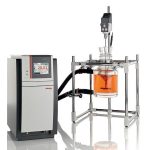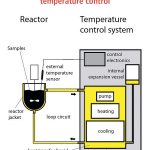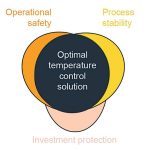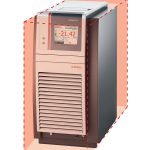Temperature control of reactors requires highly dynamic control systems. When specifying the most suitable temperature control system, a variety of conditions and influences must be taken into consideration.
The author: Thomas Pohl Marketing Communication Manager, Julabo
Most temperature control applications involve reactors made of glass or steel. Steel reactors are more robust and durable. Glass reactors allow operators to view processes within the reactor. However, glass reactors require extensive safety precautions for safe use.
When choosing a highly dynamic temperature control system, optimum functionality and maximum efficiency are called for. An evaluation system should be based on safety. The safety of the operating personnel should be the top priority of such a system. The final decision must additionally reflect three further criteria and their maximum intersection: process stability, investment protection and operational safety.
Process stability
The construction materials and dimensions have a significant influence on the temperature control of reactors. The surface area and wall thickness also have an enormous influence on precision. Effective mixing of the starting materials within the reactor is very important for achieving good homogeneity and optimal head exchange.
The temperature control application must not exceed the maximum permissible pressure values during operation under any circumstances. The applicable limits of the reactor must be programmed before starting up a temperature control application.
The maximum permissible temperature difference (delta T limit) defines the maximum difference between the temperatures in the jacket and those inside the reactor. Any temperature control equipment should allow the limit value to be programmed for the Delta T limit per time unit.
Within the temperature control system itself, the following three components greatly influence process stability:
- Heat exchanger
- Pump
- Control electronics
A temperature control solution must possess adequate cooling and heating capacity. This also defines the speed to reach desired temperature setpoints. To determine the required heating/cooling capacities, the user must consider the mass of the samples, the necessary difference in temperature and the desired cool-down and heat-up times as well as the specific heat capacity of the temperature control medium. The temperature control system’s integrated pump must be powerful and it must achieve high flow rates at constant pressure. The pump should provide the required pressure quickly and with maximum control. Advanced temperature control systems feature pumps that balance changes in the viscosity of the heat transfer liquid automatically and dynamically to ensure continuous maintenance of energy efficiency. Magnetically coupled pumps guarantee a hydraulically sealed thermal circuit.
The sophisticated electronics of a temperature control system constantly monitor and control the process within the reactor as well as the internal processes of the system. Whenever a control variable changes, the system quickly readjusts it to the setpoint – without overshooting. One way to evaluate control electronics is to examine the effort required to set parameters. Ideally, a temperature control system will only require the user to enter a setpoint. During the temperature control process, the control electronics should be self-optimising for the best possible results.
Internal expansion vessels must be of adequate size. In addition, separate cooling of the expansion vessel will ensure that the temperature control system itself cannot overheat and present a risk of injury to the operator.
A temperature control system should work reliably even at elevated temperatures. In many cases, the actual work environment will deviate from the ideal temperature of +20 °C. Modern temperature control systems work without any problems at ambient temperatures of +35 °C.
Investment protection
A highly dynamic temperature control system is a major investment. The costs for the reactor system and raw materials are often significantly higher. For this reason, a temperature control system must not only deliver a high return on investment (ROI) but also provide reliable protection for the system and reaction materials.
The pump integrated into the control system must produce adequate and continuously controlled pressure, thereby protecting the application and preserving the value of the investment. A self-lubricating pump will operate with virtually no wear, minimising mainte-nance, downtime and resulting costs.
Seen as an element of investment, a wide working temperature range means flexibility. For example, one temperature control unit will be able to handle several different applications at a variety of temperatures and within short time intervals. Air-cooled units will eliminate the expense of cooling water.
Not yet expressed in financial terms, minimising the installation space is an added benefit. The simple footprint of a temperature control system is not the only point of interest. The space requirement for connections and supply and exhaust air must be considered. Space-optimised units feature connections and venting slits at the back and front only.
Operational safety
The system operator is primarily responsible for ensuring the operational safety of the system. However, conscientious manufacturers of temperature control systems make continuous efforts to integrate improvements into their products that support the user during installation, initial operation and daily lab work.
Modern temperature control systems feature displays which provide a clear and well-organ-ised summary of all critical information in the form of plain text notices. The integrated touch screen further improves user friendliness. An integrated password protection mechanism allows multiple user levels with the ability to lock out the key pad and restrict access to the instrument parameters. Modern interface standards such as Ethernet or USB create ideal conditions for accessing all systems remotely.
It is common practice to conduct a series of experiments under identical temperature conditions or repeat failed experiments using exactly the same control parameters. The temperature control system should contain functions that enable precise reproducibility and test documentation.
Ultimately, the specification of the most suitable temperature control system includes all essential criteria: process stability, investment security and operational safety.
The complete whitepaper and checklists for evaluating the most suitable temperature control system can be requested from Julabo.
cpp-net.com/0112450
Share:










